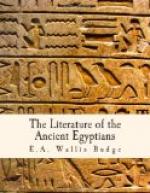him, which shrivelled him up, and the fire of the
god consumed him entirely. In the temple of Amen-Ra
the priests recited the spells that were supposed
to help the Sun-god to burn up Aapep, and they burnt
waxen figures of the monster in specially prepared
fires, and, uttering curses, they trampled them under
foot and defiled them. These spells and burnings
were also believed to break up rain clouds, and to
scatter fog and mist and to dissipate thunder-storms,
and to help the sun to rise on this world in a cloudless
sky. Aapep was a form of Set, the god of evil
of every kind, and his allies were the “Red Fiends”
and the “Black Fiends,” and every power
of darkness. In the midst of the magical spells
of this papyrus we find two copies of the “Book
of knowing how Ra came into being, and of overthrowing
Aapep.” One copy is a little fuller than
the other, but they agree substantially. The words
of this book are said in the opening line to have
been spoken by the god Nebertcher, i.e. the
“Lord to the uttermost limit,” or God Himself.
The Egyptian Christians, or Copts, in their religious
writings use this name as an equivalent of God Almighty,
the Lord of All, the God of the Universe. Nebertcher
says: “I am the creator of what hath come
into being. I myself came into being under the
form of the god Khepera. I came into being under
the form of Pautti (or, in primeval time), I formed
myself out of the primeval matter, I made myself out
of the substance that was in primeval time."[1] Nothing
existed at that time except the great primeval watery
mass called NU, but in this there were the germs of
everything that came into being subsequently.
There was no heaven, and no earth, and the god found
no place on which to stand; nothing, in fact, existed
except the god. He says, “I was alone.”
He first created himself by uttering his own name
as a word of power, and when this was uttered his
visible form appeared. He then uttered another
kind of word of power, and as a result of this his
soul (ba) came into being, and it worked in
connection with his heart or mind (ab).
Before every act of creation Nebertcher, or his visible
form Khepera, thought out what form the thing to be
created was to take, and when he had uttered its name
the thing itself appeared in heaven or earth.
To fill the heaven, or place where he lived, the god
next produced from his body and its shadow the two
gods Shu and Tefnut. These with Nebertcher, or
Khepera, formed the first triad of gods, and the “one
god became three,” or, as we should say, the
one god had three aspects, each of which was quite
distinct from the other. The tradition of the
begetting of Shu and Tefnut is as old as the time
of the pyramids, for it is mentioned in the text of
Pepi I, l. 466. The next act of creation resulted
in the emerging of the Eye of Nebertcher (later identified
with Ra) from the watery mass (NU), and light shone
upon its waters. Shu and Tefnut then united and
they produced Keb, the Earth-god, and Nut, the Sky-goddess.




